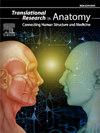Reliability of using CBCT scans to derive the parameters of the facial canal
Q3 Medicine
引用次数: 0
Abstract
Purpose
Studies have analysed the facial canal (FC) parameters using dissection or imaging technologies. To date, no studies have analysed the differences between these methods. The purpose of this study was to evaluate the reliability and accuracy of deriving the parameters from the FC on cone-beam computed tomography (CBCT) scans by comparing it to FC morphometric analyses of dissected heads.
Methods
Ten embalmed heads (n = 20) were CBCT scanned and analysed using ImageJ. Next, each FC segment was dissected. Measurements for both methods included the proximal and distal diameters and lengths for each segment, and angles of the first and second genua.
Results
The paired t-test indicated significant differences (p < 0.05) between the CBCT and dissected measurements for most FC segments measured. The respective dissection measurements were consistently higher than the CBCT measurements. However, the Bland-Altman plots showed agreement between the two modalities in measuring FC segments. Interobserver error values were 0.963 and 0.950 for the CBCT and dissection groups, respectively, indicating a high repeatability.
Conclusion
Although the current study showed differences between the parameters of the FC derived from CBCT scans and dissected measurements, CBCT scans remain a valuable tool for non-invasive assessments. However, the differences have implications for modelling in that CBCT measurements underestimate the true size for the various segments of the FC. It is worth noting that a potential difference in segment sizes may exist between populations but will have no effect on using CBCT scans as a pre-operative assessment of the FC.
使用CBCT扫描得出面部管参数的可靠性
目的研究采用解剖或成像技术对面管(FC)参数进行分析。迄今为止,还没有研究分析过这些方法之间的差异。本研究的目的是评估锥束计算机断层扫描(CBCT)中FC参数的可靠性和准确性,并将其与解剖头部的FC形态计量学分析进行比较。方法对20例经防腐处理的头颅进行CBCT扫描,并用ImageJ进行分析。接下来,切开每个FC节段。两种方法的测量包括每个节段的近端和远端直径和长度,以及第一和第二膝的角度。结果配对t检验显示差异有统计学意义(p <;对于大多数FC节段的测量,CBCT和解剖测量之间的差异为0.05)。各自的解剖测量值始终高于CBCT测量值。然而,Bland-Altman图显示在测量FC段时两种方式是一致的。CBCT组和夹层组的观察者间误差值分别为0.963和0.950,重复性高。尽管目前的研究显示CBCT扫描和解剖测量得出的FC参数存在差异,但CBCT扫描仍然是一种有价值的非侵入性评估工具。然而,这些差异对建模有影响,因为CBCT测量低估了FC各个部分的真实大小。值得注意的是,人群之间可能存在潜在的节段大小差异,但对使用CBCT扫描作为FC术前评估没有影响。
本文章由计算机程序翻译,如有差异,请以英文原文为准。
求助全文
约1分钟内获得全文
求助全文
来源期刊

Translational Research in Anatomy
Medicine-Anatomy
CiteScore
2.90
自引率
0.00%
发文量
71
审稿时长
25 days
期刊介绍:
Translational Research in Anatomy is an international peer-reviewed and open access journal that publishes high-quality original papers. Focusing on translational research, the journal aims to disseminate the knowledge that is gained in the basic science of anatomy and to apply it to the diagnosis and treatment of human pathology in order to improve individual patient well-being. Topics published in Translational Research in Anatomy include anatomy in all of its aspects, especially those that have application to other scientific disciplines including the health sciences: • gross anatomy • neuroanatomy • histology • immunohistochemistry • comparative anatomy • embryology • molecular biology • microscopic anatomy • forensics • imaging/radiology • medical education Priority will be given to studies that clearly articulate their relevance to the broader aspects of anatomy and how they can impact patient care.Strengthening the ties between morphological research and medicine will foster collaboration between anatomists and physicians. Therefore, Translational Research in Anatomy will serve as a platform for communication and understanding between the disciplines of anatomy and medicine and will aid in the dissemination of anatomical research. The journal accepts the following article types: 1. Review articles 2. Original research papers 3. New state-of-the-art methods of research in the field of anatomy including imaging, dissection methods, medical devices and quantitation 4. Education papers (teaching technologies/methods in medical education in anatomy) 5. Commentaries 6. Letters to the Editor 7. Selected conference papers 8. Case Reports
 求助内容:
求助内容: 应助结果提醒方式:
应助结果提醒方式:


